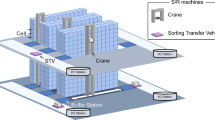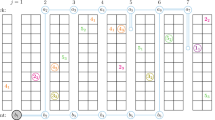Abstract
The travel time models of Automated Storage and Retrieval systems (AS/RS) machines under randomized storage proposed by Chang et al. (IIE Transactions, 27(1), 108–111, 1995), which consider the speed profiles in real-world applications, are extended in this paper. In the present study, travel time models are proposed that consider various travel speeds with known acceleration and deceleration rates. Compact forms of expected travel times under the class-based storage assignment and full-turnover-based storage assignment have been determined. The results show that both the proposed exponential travel time model and the adjusted exponential model perform satisfactorily and could be useful tools for designing an AS/RS in real-world applications.
Similar content being viewed by others
References
Bozer, Y.A. and White, J.A. (1984) Travel time models for automated storage and retrieval system. IIE Transactions, 16(4), 329-338.
Chang, D.T., Wen, U.P. and Lin, J.T. (1995) The impact of acceleration/deceleration on travel-time models for automated storage/retrieval system. IIE Transactions, 27(1), 108-111.
Eynan, A. and Rosenblatt, M.J. (1994) Establishing zones in single-command class-based rectangular AS/RS. IIE Transactions, 26(1), 38-46.
Gudehus, T. (1973) Grundlagen der Kommissioniertechnic Dynamik der Warever-teilund Lagersysteme. (Principals of Order Picking Operations in Distribution and Warehousing System), W. Girardet, Essen, West Germany.
Hausman, W.H., Schwarz, L.B. and Graves, S.C. (1976) Optimal storage assignment in automatic warehousing system. Management Science, 22(6), 629-639.
Hwang, H. and Lee, S.B. (1990) Travel-time models consider the operating characteristics of the storage and retrieval machine. International Journal of Production Research, 28(10), 1779-1789.
Kouvelis, P. and Papanicolaou, V. (1995) Expected travel time and optimal boundary formulas for a two-class-based automated storage/retrieval system. International Journal of Production Research, 33(10), 2889-2905.
Pan, C.H. and Wang, C.H. (1996) A framework for the dual command cycle travel time model in automated warehousing system. International Journal of Production Research, 34, 2099-2117.
Rosenblatt, M.J. and Eynan, A. (1989) Deriving the optimal boundaries for class-based automatic storage/retrieval system. Management Science, 35(12), 1519-1524.
Author information
Authors and Affiliations
Corresponding author
Rights and permissions
About this article
Cite this article
Wen, U., Chang, D. & Chen, S. The impact of acceleration/deceleration on travel-time models in class-based automated S/R systems. IIE Transactions 33, 599–608 (2001). https://doi.org/10.1023/A:1010848601660
Issue Date:
DOI: https://doi.org/10.1023/A:1010848601660




